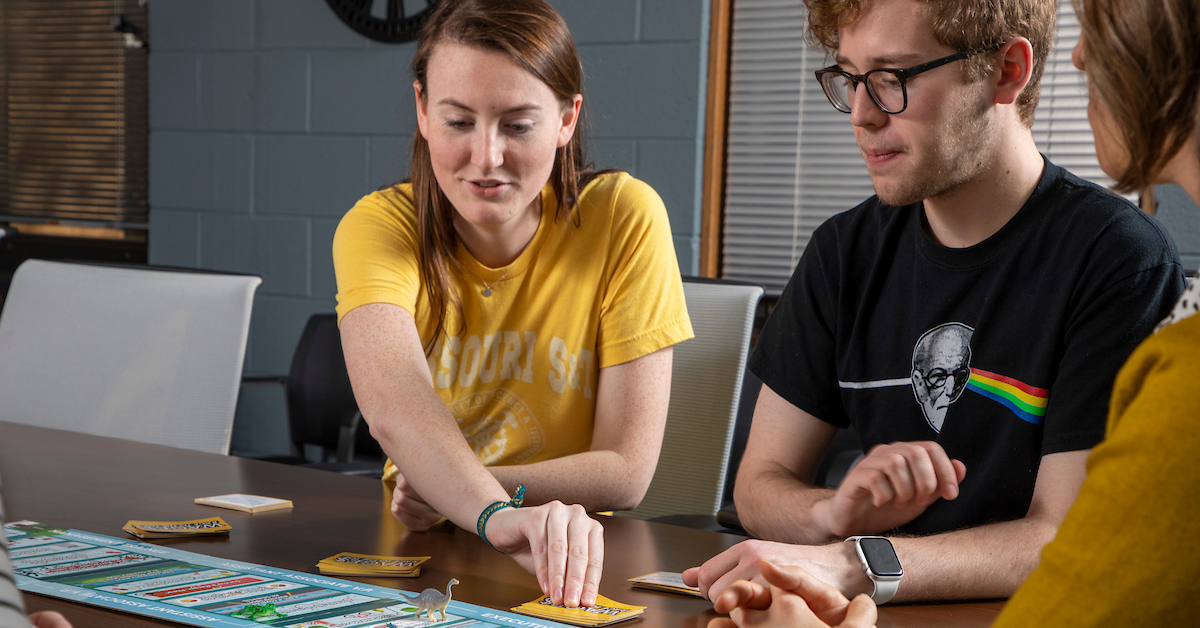The game of bias
Posted by Mary Helen Stoltz

Playing WAGES: Race to the Top with Jessica Cundiff (far right) are Rudi Starek, (left) a senior in technical communication and Tim Kruper, a 2020 psychological science graduate and research assistant on the project. Photo by Tom Wagner, Missouri S&T.
Teaching about hot-button topics like gender bias can be a challenge because those topics often threaten the way students view themselves and provoke defensiveness.
To help overcome the challenge, Jessica Cundiff, an assistant professor of psychological science, in collaboration with Leah Warner, an associate professor at Ramapo College of New Jersey, developed a game to teach students about gender bias in a way that is interactive, engaging and non-threatening.
“Drawing on experiential learning methods that engage students in a first-hand experience allows them to construct knowledge on their own through discovery and reflection, rather than merely being passive recipients of information,” Cundiff says.
The game is called WAGES: Race to the Top. WAGES is an acronym that stands for Workshop Activity for Gender Equity Simulation. Players are randomly divided into two teams, a green team (later revealed to represent women’s experiences) and a yellow team (later revealed to represent men’s experiences).
The game concept was originally developed by Stephanie Shields, a professor of psychology at Penn State University, Cundiff says. The original version targets faculty and administrators, but the new version Cundiff and Warner developed targets students.
“The object of the game is to climb the corporate ladder to be the first player with CEO status and a corner office,” Cundiff says. To advance, participants draw cards describing issues that contribute to gender inequity, like gender role expectations, salary, mentoring, workplace climate, and token status.
“A side-by-side comparison of the cards illustrates the seemingly minor biases the green team experiences compared with the yellow team’s experiences,” Cundiff explains. “For example, a green team card might read ‘A yellow team coworker gets credit for something you said at a meeting’ while the yellow team’s card would read ‘You get credit for something you said at a meeting.’
“The discrepancies between the two teams’ experiences seem small and innocuous at first, but over the course of the game, these minor discrepancies grow to produce large disparities between the two teams,” Cundiff says. “In this way, the game simulates how small gender biases accumulate to negatively affect women in the workplace.”
At the end of the game, players participate in a structured group discussion that reveals how the game represents the experiences of women and men in the workplace. The discussion also includes how gender bias intersects with racial bias and other forms of bias.
Each game card is based on published, peer-reviewed findings of gender bias, so instructors use psychological research to emphasize the five key learning objectives of the game:
- Patterns, not single incidents, are the most visible indicators of gender inequity
- Bias is often fueled by unconscious stereotyping
- Seemingly minor disadvantages accumulate over time
- Bias may manifest differently at different work stages
- Bias may be experienced differently across diverse groups of women
“Our ultimate goal is to make the game widely available for instructors to use in their classrooms,” Cundiff says. “We hope to offer a low-cost do-it-yourself option that instructors can print on their own printers, as well as an affordable high-quality professionally printed option.”
Leave a Reply